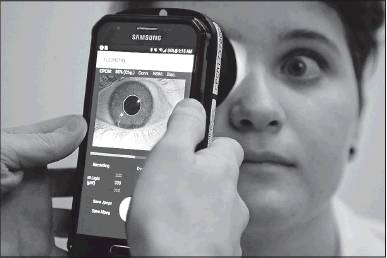MEDICAL SCIENCE
No stethoscope for pain: Scientists seek an accurate way to measure
By Lauran Neergaard The Associated Press
WASHINGTON — Is the pain stabbing or burning? On a scale from 1 to 10, is it a 6 or an 8?
Over and over, 17-year-old Sarah Taylor struggled to make doctors understand her sometimes debilitating levels of pain, first from joint-damaging childhood arthritis and then from fibromyalgia.
“It’s really hard when people can’t see how much pain you’re in, because they have to take your word on it and sometimes, they don’t quite believe you,” she said.
Now scientists are peeking into Sarah’s eyes to track how her pupils react when she’s hurting and when she’s not — part of a quest to develop the first objective way to measure pain.
“If we can’t measure pain, we can’t fix it,” said Dr. Julia Finkel, a pediatric anesthesiologist at Children’s National Medical Center in Washington, who invented the experimental eye-tracking device.
At just about every doctor’s visit you’ll get your temperature, heart rate and blood pressure measured. But there’s no stethoscope for pain. Patients must convey how bad it is using that 10-point scale or emoji-style charts that show faces turning from smiles to frowns.
That’s problematic for lots of reasons. Doctors and nurses have to guess at babies’ pain by their cries and squirms, for example. The aching that one person rates a 7 might be a 4 to someone who’s more used to serious pain or genetically more tolerant. Patient-to-patient variability makes it hard to test if potential new painkillers really work.
Nor do self-ratings determine what kind of pain someone has — one reason for trial-and-error treatment. Are opioids necessary? Or is the pain, like Sarah’s, better suited to nerve-targeting medicines?
“It’s very frustrating to be in pain and you have to wait like six weeks, two months, to see if the drug’s working,” said Sarah, who uses a combination of medications, acupuncture and lots of exercise to counter her pain.
The National Institutes of Health is pushing for development of what its director, Dr. Francis Collins, has called a “pain-o-meter.” Spurred by the opioid crisis , the goal isn’t just to signal how much pain someone’s in. It’s also to determine what kind it is and what drug might be the most effective.
“We’re not creating a lie detector for pain,” stressed David Thomas of NIH’s National Institute on Drug Abuse, who oversees the research. “We do not want to lose the patient voice.”
Around the country, NIHfunded scientists have begun studies of brain scans, pupil reactions and other possible markers of pain in hopes of finally “seeing” the ouch so they can better treat it. It’s early-stage research, and it’s not clear how soon any of the attempts might pan out.
“There won’t be a single signature of pain,” Thomas predicted. “My vision is that someday we’ll pull these different metrics together for something of a fingerprint of pain.”
NIH estimates 25 million people in the U.S. experience daily pain. Most days Sarah Taylor is one of them. Now living in Potomac, Maryland, she was a toddler in her native Australia when the swollen, aching joints of juvenile arthritis appeared. She’s had migraines and spinal inflammation. Then two years ago, the body-wide pain of fibromyalgia struck; a flare-up last winter hospitalized her for two weeks.
One recent morning, Sarah climbed onto an acupuncture table at Children’s National, rated that day’s pain a not-too-bad 3, and opened her eyes wide for the experimental pain test.
“There’ll be a flash of light for 10 seconds. All you have to do is try not to blink,” researcher Kevin Jackson told Sarah as he lined up the pupil-tracking device, mounted on a smartphone.
